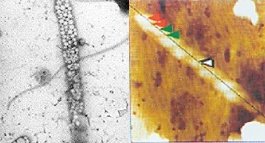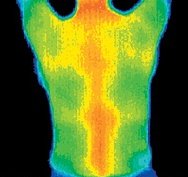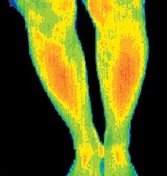What are meridians? Are they real? If they are real, what are they made of? Can we see them? These are simple and innocuous questions that an acupuncturist may find difficult to reply to satisfactorily when asked by inquisitive patients who want a modern scientific answer.
When we cut open the human body, we do not see any trace of meridians, unlike like blood vessels or nerve fibers. On the other hand, acupuncturists see daily the curing effects of acupuncture, using the meridians as a guide. How can these questions be answered?
A recent book written by this columnist, The Biophysics: Basis for Acupuncture and Health,* answers these questions, derived from massive scientific and clinical evidence gathered over the last 15 years. Here are some highlights from the book on the properties of meridians from research done in excellent centers and institutions around the world (the United States, Britain, Japan, Sweden, China, et al.).
A. Meridians as optical fiber - optical properties of meridians
- Some meridians are weakly luminescent. In some people, the meridians are visible via infrared imaging.
- One experiment finds that a meridian is transparent to infrared radiation in 2.66um and 10um, but opaque in its transverse direction.
- Water and normal tissue are opaque to infrared radiation at 10um. Our stable water clusters act like a solid, or liquid crystal, and could be transparent.
B. Meridians as conductors - evidence for low impedance along the meridians
- Low skin impedance was observed along three meridians and the Ren and Du meridians.
- Low impedance lines and high percussion sound lines coincide on meridians.
- Acupuncture at acupoint PC 3 on the pericardium meridian lowers impedance of the pericardium meridian from 52 Kohm to 9 Kohm.
- Low impedance along meridians has been measured by computerized methods and is highly repeatable.
Water or aqueous solutions conduct electricity better than normal skin tissue.
C. Difference between 2 Hz and 100 Hz in electroacupuncture
- Meridians act like the cable in a cable television system. Different frequencies in the transmission line will give different programs in the receiving television set, as different frequencies in meridians will have different effects on the related organs or physical systems.
- 2 Hz increases somatostantin (SOM) and decreases calcitonin gene-related peptide (CGRP); 100 Hz inhibits SOM, and has no effect on CGRP.
- 2 Hz is good as an analgesic for a rat, but not 100 Hz.
- Different frequencies produce different types of opioid effects. 2 Hz is mediated by the mu- and delta-receptors; 100 Hz is mediated by kappa-receptors.
- The hypothalamus plays a role in mediating low, but not high frequency in electro-acupuncture (EA) analgesia.
D. Meridians as plastic tubes with water: propagation of sensation along meridians (PSM)
When a needle was inserted into the acupoint, some patients would occasionally feel a sensation radiating from the acupoint. The sensation did not propagate randomly in any direction, but along the meridian where the acupoint was located.
- Young people feel PSM more distinctly and more frequently than adults.
- The improvement of vision from acupuncture among youngsters who feel PSM is much better than among those who do not.
- Acupuncture on the hand at acupoint he gu (LI 4) of the Large Intestine meridian stimulates the retina, as was recorded by an electroretinogram (ERG).
- Mechanical pressure: If mechanical pressure is applied on the acupoint between the hand and the eyes along the Large Intestine meridian, the signal is blocked, as measured by ERG.
 The picture on the left was taken by transmission electron microspope (Hitachi H660, 100 keV electron beam, 6,000X) on a chain of water clusters. The width of the chain had several clusters. The size of the small circular clusters inside the chain is about 0.3 micron in diameter. The picture on the right showed similar water clusters joining together one after another in a chain. The picture was taken with an atomic force microscope (Digital Instrument, Santa Barbara, Calif). The size of clusters is similar to those on the left.
These studies seem to suggest that the qi flows in the meridian similarly to how a water wave might flow in a plastic tube. The wave can be stopped by squeezing the plastic tube in the middle. Since anatomically there have been no tube-like objects found, meridians may be more like underground water, with no definite boundaries.
The picture on the left was taken by transmission electron microspope (Hitachi H660, 100 keV electron beam, 6,000X) on a chain of water clusters. The width of the chain had several clusters. The size of the small circular clusters inside the chain is about 0.3 micron in diameter. The picture on the right showed similar water clusters joining together one after another in a chain. The picture was taken with an atomic force microscope (Digital Instrument, Santa Barbara, Calif). The size of clusters is similar to those on the left.
These studies seem to suggest that the qi flows in the meridian similarly to how a water wave might flow in a plastic tube. The wave can be stopped by squeezing the plastic tube in the middle. Since anatomically there have been no tube-like objects found, meridians may be more like underground water, with no definite boundaries.
E. Constituents inside meridians are charged - evidence for meridians, ionic and others
- Calcium ions are found to concentrate along the Stomach and Gallbladder meridians, by the method of external proton beam-induced X-ray emission (PIXE).
- Concentration of hydrogen ions is found to increase along the Heart and Pericardium meridians for rabbits suffering from arrhythmia induced by aconitine.
- The mast cells were found to concentrate more along the meridian lines in 19 amputated limbs of patients and rats.
 The back of a very healthy woman, whose Du meridian shows up as a red (warm) line at her back, as indicated in a thermogram. Some systematic work has been done on healthy people, which demonstrates that some portions of meridians naturally show up in thermograms for a small percentage of people.
The constituents of meridians must satisfy the above properties. Since meridians cannot be distinguished from surrounding tissues, they must be made up of constituents similar to tissues around them. The striking difference is their electrical properties, so the simple logical solution is that they are made up of an electrically polarized medium. The body is more than 70 percent water, so a likely solution is that meridians are made up of polarized stable water clusters, with positive and negative charges at their ends. They can easily attract, and hence concentrate ions. They can conduct electricity better, allow waves to propagate, and transmit infrared radiation of certain frequencies as discussed above. Such polarized water clusters with permanent electric dipole moments have been discovered in the laboratory and outside the human body. They do line up, as shown in the two pictures above.
The back of a very healthy woman, whose Du meridian shows up as a red (warm) line at her back, as indicated in a thermogram. Some systematic work has been done on healthy people, which demonstrates that some portions of meridians naturally show up in thermograms for a small percentage of people.
The constituents of meridians must satisfy the above properties. Since meridians cannot be distinguished from surrounding tissues, they must be made up of constituents similar to tissues around them. The striking difference is their electrical properties, so the simple logical solution is that they are made up of an electrically polarized medium. The body is more than 70 percent water, so a likely solution is that meridians are made up of polarized stable water clusters, with positive and negative charges at their ends. They can easily attract, and hence concentrate ions. They can conduct electricity better, allow waves to propagate, and transmit infrared radiation of certain frequencies as discussed above. Such polarized water clusters with permanent electric dipole moments have been discovered in the laboratory and outside the human body. They do line up, as shown in the two pictures above.
The properties of these stable water clusters have been collected in a book, First International Conference on the Physical, Chemical and Biological Properties of Stable Water Clusters, held in Los Angeles and edited by B. Bonavita and myself (World Science Publishing Co. 1977).
Can we actually see these meridians on the human body? Yes. We can see them sometimes with infrared imaging. They are thicker and less sharp than the lines of meridians drawn in an acupuncture textbook. (We do not thoroughly understand this yet. More research is needed.) One of the meridians in a healthy person is shown below:**
We can also see the meridians of some people who are sick:
In conclusion, we can answer the questions raised in the beginning of this article. Meridians are made up of a polarized medium, which is most likely stable water clusters with permanent electric dipole moments. This basically confirms the folklore that water is the source of life. We can actually see some parts of the meridians in some people, some of the time, using an infrared imaging technique.
As we apply modern scientific methods to study meridians, I believe that the real nature of meridians will become more clear, and should eventually become accepted by Western scientists as being as real as blood vessels or nerve fibers.
* This book can be ordered from Booksurge.com or Amazon.com.
** The meridians of most healthy people do not show up on a thermogram.
Click here for previous articles by Yin Lo, PhD.






